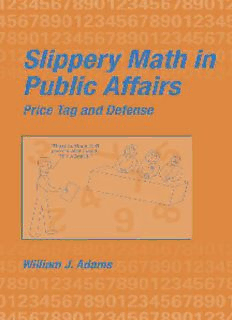
Slippery math in public affairs: price tag and defense PDF
Preview Slippery math in public affairs: price tag and defense
Slippery Math in Public Affairs Price Tag and Defense William J. Adams Pace University New York,New York with illustrations by . Ramune B. Adams Marcel Dekker, Inc. New York Basel • TM Copyright © 2002 by Marcel Dekker, Inc. All Rights Reserved. ISBN: 0-8247-0790-7 Thisbookisprintedonacid-freepaper. Headquarters Marcel Dekker,Inc. 270 MadisonAvenue,NewYork,NY10016 tel: 212-696-9000;fax:212-685-4540 EasternHemisphereDistribution Marcel DekkerAG Hutgasse 4,Postfach812,CH-4001Basel,Switzerland tel: 41-61-261-8482;fax:41-61-261-8896 WorldWideWeb http://www.dekker.com Thepublisheroffersdiscountsonthisbookwhenorderedinbulkquantities.For moreinformation,writetoSpecialSales/ProfessionalMarketingattheheadquar- ters addressabove. Copyright 2002byMarcelDekker,Inc. AllRightsReserved. Neitherthisbooknoranypartmaybereproducedortransmittedinanyformor by any means, electronic or mechanical, including photocopying, microfilming, andrecording,orbyanyinformationstorageandretrievalsystem,withoutper- missioninwritingfromthepublisher. Currentprinting(lastdigit): 10 9 8 7 6 5 4 3 2 1 PRINTEDIN THEUNITEDSTATESOFAMERICA To Onute˙, Andrius, Barbara, Brian, Ramune˙, Gaja, Rasa, and Roksi Preface Plato believed that knowledge of mathematics is a prerequisite for good citizenship.Inourageitwouldbeappropriatetoconsiderknowledgeof howslipperymathentersthepublic arenaandwhatwecandotoavoid being‘‘taken’’tobeaprerequisiteforeffectiveparticipationinpublicaf- fairs. Inbrief,thisbookaddressesthispost-Platostateofaffairs.Indoing so, it presupposes no specialized knowledge of mathematics on the part of the reader, just interest in how mathematics may deceive us, the cost, and what we can do about it. Slipperymathinpublicaffairs?Atfirstthethoughtmightstrikeone as an oxymoron. After all, many of us would submit that in terms of precision, mathematics is as good as it gets. We acquire such a view of mathematics at an early age and it stays with us, although with further education and life experience we come to realize that math is not quite all that it’s cracked up to be. In a sense math is like a respectable public figure whom we are drawn to because he projects strength, objectivity, andlogicalpower,butwhomwealsosensehasashadowysidewecan’t quite pinpoint. Our degree of vulnerability to being seduced by the Svengali-like presence of mathematics depends on the faith and trust we have in its power, balanced by our sense of caution and doubt. Alas, the hypnotic power of mathematics far too often scores a complete triumph. This was brought home to me by the reaction of a student to an argument I had presented concerning a dean who had been told that his work was counterproductive. The argument purported to show, by ‘‘mathematical v vi Preface proof,’’thatthedeandidnoworkatall,andthusthatthechargehadno basis.ThepointIwasattemptingtomakewasthat‘‘mathematicalproof’’ couldgenerate nonsenseand that if itdid soone wouldbewell advised to take a close look at the mathematical proof and its starting point. My studentLaurawouldhavenoneofit;Ihad‘‘proved’’theresultbymathe- maticalreasoningandthatwasthat;caseclosed.It’senoughtomakeone want to laugh and cry at the same time. Although Laura might seem an extreme case, the fact is that we all have a bit of Laura in us. The following questions warrant consideration: 1. What is slippery math and how does it arise? 2. Whathavebeentheconsequencesofslipperymathinthepublic arena? 3. How is math employed to sell a point of view to the public? 4. Withbillionsofdollarsandendlesstalkgivenovertoimproving mathematics education, how could it happen that math can be employed to mislead most of the people most of the time? 5. Whatreformsinmathematicseducationareneededtohelppre- pare future generations to participate effectively in a society inwhichmathematicsisincreasinglybeingemployedandmis- employed in the public arena? 6. Whatcanwedotomakeourselveslessvulnerabletobeingma- nipulated by slippery math? 7. What can we do to help policy decision making reflect more reliable and well-chosen numbers and math models? The setting for addressing these questions is established in Parts 1 through 4. We return to them in the Epilogue. Part 1 (Chapters 1–7) ad- dresses the ways in which slippery numbers emerge in the public arena and what steps we can take to make ourselves less vulnerable to being mathmanipulated.Part2(Chapters8–13)isconcernedwiththedevelop- mentofmathportraits,calledmathmodels,forreal-worldsituations,how they can be mathematically precise and yet present a false picture, the spin doctor’s bag of tools to sell math portraits to the public, and what we can do to minimize the danger of being sold math snake oil. Part 3 (Chapters14–15)discussesthecostofslipperymathintermsofresources, life, and opportunities.Part 4 (Chapter 16) looksat how math education can be reformed to sharpen our perspective on what mathematics can and cannot do for us in its applications, and options available to us for putting together a self-study program. Preface vii I should like to express my appreciation to my daughter Ramune˙ for her illustrations, and to my daughter Rasa, Ursula Shand, Danielle Ortiz, and Eliana Cifuentes for their assistance in preparing the manu- script.IalsoshouldliketoexpressmyappreciationtothePaceUniversity community for their support of this undertaking. William J. Adams Contents Preface v PART ONE SLIPPERY NUMBERS IN THE PUBLIC ARENA 1 Introduction 2 1 Boldfaced Lies 4 The Homeless Homeless Figure 5 Indefensible Defense Figures 5 Blowing Smoke on Secondary Smoke 6 Shenanigans in Science 7 The Drug Testing Balloon That Popped 8 2 Something’s Amiss 10 It Sounds Good, But . . . 11 Accounting Alchemy: From Lead to Gold 12 Get It ‘‘Right’’ This Time 14 Conflicts of Interest 15 Wounded Military Figures 19 A Question of ‘‘Accuracy’’ 21 ix
Description: